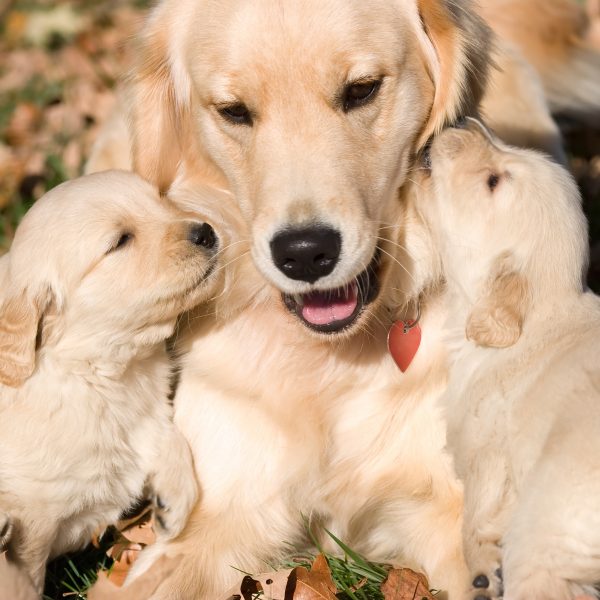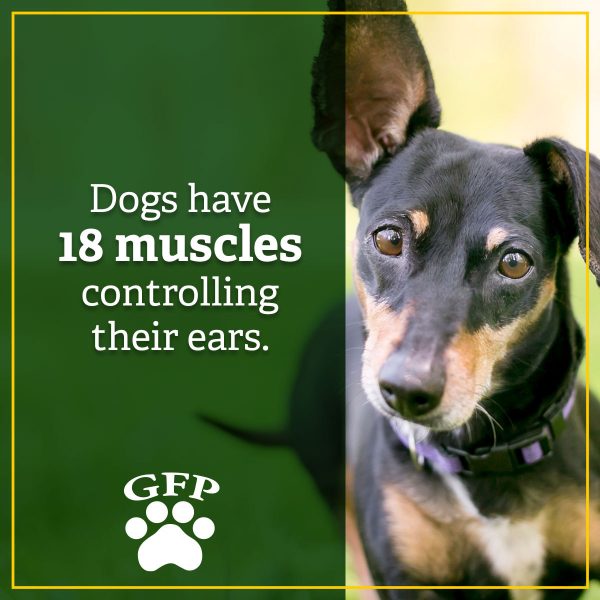How to Clean Your Dog’s Ears

There is more to taking care of your dog than just maintaining and grooming their coat – their nails, teeth, and ears all need care too. As such, knowing how to clean your dog’s ears, nails, and teeth is a big help.
Your dog’s ear can get dirty, trap moisture or debris, or have an excess buildup of wax. Floppy ears tend to trap more and are more prone to ear infections than ears that point up all the time.
However, it’s important to regularly check your dog’s ears and to carefully clean them as needed no matter what type of ears they have. Here’s how to clean your dog’s ears:
How to Clean Your Dog’s Ears
Here are some tips for how to clean your dog’s ears:
1. Get the Right Supplies
Your dog’s ears are sensitive, so you want to make sure you have the right supplies in order to clean them without causing damage. Here are some of the basic supplies you will need:
Ear Cleaner
You need to use a high-quality ear cleaner for dogs and the right one for what you need. Cleaners containing hydrogen peroxide or alcohol may seem like a good choice, but these ingredients are harsh and can cause irritation inside the ear canal.
This is particularly true if your dog’s ear canal is already inflamed, irritated, or ulcerated. On top of that, your dog’s ear canal runs longer and deeper than yours, which makes irritation in that area even more painful and difficult.
It’s best to talk to your vet about what ear cleaners are best for your dog and which type you should be using. Some ear cleaners are a better solution for excessive wax while others are better at helping to prevent ear infections because they have antibacterial or antifungal properties.
Cotton Balls or Gauze
You also want to have some cotton balls or gauze on hand to assist in cleaning your dog’s ears. It’s important to use cotton balls or gauze and NOT to use Q-tips or similar cotton tip applicators.
Seriously, do not use cotton tip applicators!
Not only can these rupture the eardrum or cause other trauma to your dog’s ear canal, but they also can push debris or wax further in causing it to become impacted or infected.
Treats Don’t Hurt
It’s also a good idea to have treats available so you can reward your dog. This is particularly helpful if you’re just starting to get your puppy used to having their ears handled, checked, and cleaned.
2. Position Your Dog for Comfortable Cleaning
You want to make sure you position your dog so that cleaning is more comfortable for them and easily accessible for you.
You can sit on the floor with small to medium dogs. They can sit between your legs while facing away from you. This allows you to easily reach their ears while also keeping them securely in place.
Larger dogs can be positioned sitting with their back facing a corner with a wall on one side and you standing on the other. This can make it easier for you to reach a larger dog’s ears while also being able to keep them securely in place.
3. Hold the Ear Up and Squeeze Some Ear Cleaner Into it
Whether your dog has floppy ears or ears that stick up, you want to hold the ear flap up pr gently pull up on their ear as this helps expose the ear canal and also straightens it out for easier application. While holding the ear, squeeze enough cleaning solution into your dog’s ear to fill the ear canal completely.
It’s important that you do not put the tip of the bottle into the ear!
It’s okay if some ear cleaner spills out of your dog’s ear canal, but you want to avoid having the tip of the bottle touch the ear or enter the ear canal.
If it does touch your dog’s ear, make sure you clean it before using it on the other ear. Usually, using a clean cotton ball soaked in alcohol to wipe off the tip is sufficient to prevent bacteria from spreading.
4. Massage the Base of the Ear
While still holding up your dog’s ear, use your other hand to gently massage the base of the ear. Massaging just below the ear canal for about 30 seconds allows the cleaner to soften and break up debris within the ear canal.
Don’t worry if you hear a squishing sound – that’s normal! It’s just the cleaner moving around within the ear canal.
5. Wipe With Cotton Ball or Gauze
With your dog’s ear still held up, take a cotton ball or gauze and gently wipe any debris away from the upper ear canal or inner part of your dog’s ear flap. Then, let go of your dog’s ear.
6. Let Your Dog Shake it Off
After the initial wipe, let your dog shake their head a few times. Not only will this provide them some relief from the discomfort of having liquid in their ear, but it will also help move remaining cleaner and debris from the interior ear canal to the outer ear.
7. Wipe the Ear Again
Once you’ve let your dog shake their head, hold their ear up again and use another cotton ball or gauze pad to wipe away debris and cleaning solution from the outer ear. Although you can go into the ear canal a little bit to help clean away anything remaining, you do not want to go any deeper than your finger can comfortably reach.
8. Reward, Repeat on the Other Ear, and Reward Again
Reward your dog for letting you clean their ear. Then, repeat the process on the other ear, if needed, and reward your dog again.
4 Tips for Cleaning Your Dog’s Ears
Caring for your dog’s ears should be a regular part of their grooming routine. However, how often you clean your dog’s ears will depend on your dog and there are some situations where you shouldn’t clean your dog’s ears. Here are some things to keep in mind:
1. Talk to Your Vet First
Before you jump in and start cleaning your dog’s ears, make sure you talk to your vet first.
You should clean your dog’s ears when it’s needed, but you don’t need to clean them if it’s not necessary. Some dogs may require more cleanings while others may never require their ears to be cleaned. Your vet can help you determine how often your dog’s ears need to be cleaned, if at all.
Talking to your vet first is especially important if you notice your dog’s ears have a bad odor, discharge, or look red or inflamed. In these cases, your dog could have an ear infection or possibly even a ruptured eardrum.
Cleaning your dog’s ears in these cases could worsen the situation, cause damage, and more. After assessing the situation, your vet will let you know how to best care for these situations.
2. Understand the Anatomy of a Dog’s Ear
Dogs’ ears are sensitive and allow them to hear sounds far beyond the scope of human ears. This also means they can be easily damaged. Learning more about the anatomy of a dog’s ear can help you out when it comes to inspecting and cleaning them. A dog’s ear can be broken down into two major sections: the outer ear and the inner ear.
Outer Ear
The outer ear refers to the visible part of your dog’s ear that is located on the exterior of their head. It is made up of two basic “parts” the pinna and the middle ear.
Pinna
The Pinna is the correct term for the ear flap, which is the most recognizable part of a dog’s ears because it is the most visible. It’s also what contributes a great deal to the distinctive look of each breed. Your dog may have Pinna that flop over or stick straight up. You can also see the ear canal at the base of the Pinna, which is a bit bumpy at its outermost portion before winding its way into the middle ear.
Middle Ear
The Middle Ear consists of a portion of the ear canal and the eardrum, which is also called the tympanic membrane. Just behind the eardrum are a set of extremely small auditory bones that resonate sound pulses to the inner ear.
Inner Ear
The Inner Ear is filled with cilia, which are tiny hair-like strands that convert sound pulses into electronic ones that are delivered to the brain. The brain then interprets these signals as distinct sounds like voices, cars, other dogs barking, etc.
Much like humans, a dog’s Inner Ear also helps them maintain their balance. Damage to this area can affect balance and movement and can lead to vestibular disease in dogs.
3. Do Not Over-Clean
Your dog’s ears are sensitive. Cleaning them unnecessarily or too often can cause irritation within the ear canal and even lead to ear infections.
Your vet can give you a good idea of what to look for and how often to clean your dog’s ears. Depending on your dog, you may never need to clean their ears!
4. Stop If Your Dog Shows Signs of Pain
If your dog shows any signs of pain while you are cleaning their ears, stop what you are doing and make an appointment with the vet.
Cleaning your dog’s ear shouldn’t hurt. If it does, something is going on and you want your vet to take a look before you do anything else.
Even if it’s just your cleaning technique that needs an adjustment, your vet can help.
5. Clean Before Applying Medication
If your dog has an ear infection, your vet may have provided some medication to help heal it. Your vet will give you specific instructions for using the medication. It’s a general practice to clean your dog’s ears before applying medication unless your vet has recommended against it.
You only need to carefully clean your dog’s ears as needed, but you should be checking your dog’s ears on a weekly basis. This is important to prevent ear infections and also to prevent pests. The ears are one of the places to look for ticks on your dogs as well as fleas and other pests. With these steps for how to clean your dog’s ears, you’ll be ready to go if it needs to be done.

